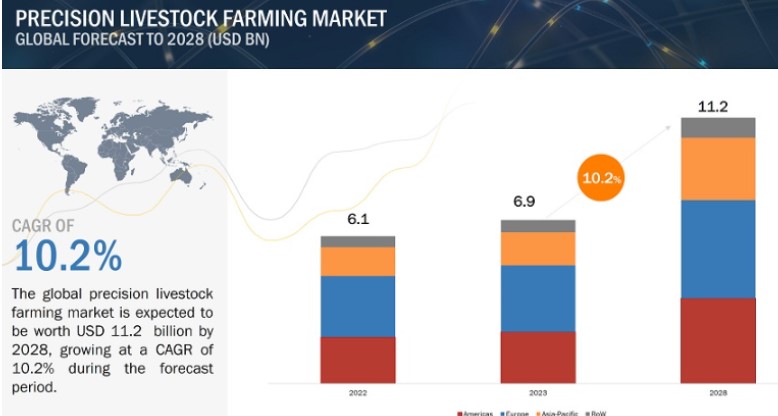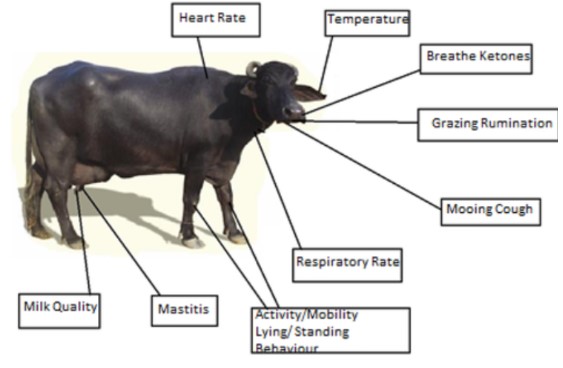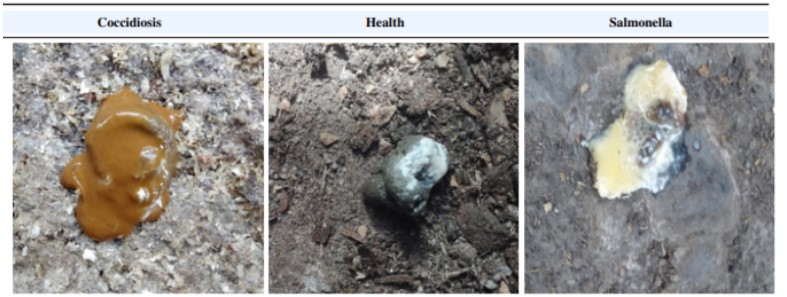Introduction:
In livestock management, AI (Artificial Intelligence) plays a crucial role in optimising various aspects of animal husbandry. By leveraging advanced technologies such as machine learning, computer vision, and data analytics, AI applications in agriculture are transforming how livestock is raised and managed. From monitoring health and behaviour patterns to improving breeding strategies and optimising feeding practices, AI-driven solutions contribute to the overall well-being of livestock and help farmers make more informed decisions. According to a report by MarketsandMarkets, the Precision Livestock Farming market is projected to reach USD 11.2 billion by 2028, growing at a CAGR of 10.2% (MarketsandMarkets, 2023).

Below are some use cases of how AI is transforming livestock management:
Precision Livestock Monitoring
In agriculture, keeping an eye on livestock, like cows, sheep, and pork, is so important. With new technologies, especially artificial intelligence, farmers can now monitor their animals more effectively. They use tools like cameras and sensors to watch over the health and behaviour of the animals. This helps farmers spot potential issues early on, ensuring that the livestock is healthy and happy. It’s like having a smart assistant on the farm, ensuring everything is going well and allowing farmers to take better care of their animals. Here’s an example of how livestock monitoring with artificial intelligence works:

On a modern farm, cameras and sensors are set up in the barn where the cows are kept. These smart devices are connected to a computer system that uses AI. The cameras constantly watch the cows, and the sensors collect data on things like how much they eat, move, and even their body temperature. The AI system analyses this information in real time. If a cow seems a bit unwell or isn’t eating as much as usual, the system can alert the farmer. This early notification allows the farmer to check on the cow and promptly provide necessary care. It’s a bit like having a virtual farm assistant that helps farmers take quick action to keep their animals healthy and content.
Enhancing Animal Well-Being
Enhancing animal welfare has become an imperative focus in agricultural practices, leading to developing and implementing strategies for the optimal care and well-being of animals. Animal welfare optimisation involves various measures to ensure that animals raised in agricultural settings experience good health, comfort, and humane treatment.
Internet of Things (IoT) edge computing plays a significant role in optimising animal welfare. Here’s how IoT edge computing is utilised to enhance animal welfare in terms of food and drinking optimisation:
- Automated Feeding Systems (AFSs): IoT sensors placed on feeding equipment can monitor the eating habits of individual animals. These devices track how much each animal eats, and the data is processed locally on the edge, allowing for real-time adjustments in feeding schedules and portion sizes. This ensures that each animal receives the appropriate amount of nutrition tailored to its needs. “The use of automated feeding systems has led to an estimated 5-10% reduction in feed costs, as reported by the Food and Agriculture Organization (FAO). In Nabokov et al.’s study, the regular feeding of the animals increased the farm’s production potential, which resulted in a high return on investment (87.8%).
- Water Quality Monitoring: IoT sensors can be integrated into water supply systems to monitor the quality and availability of drinking water. Edge computing allows for immediate analysis of factors like water temperature and cleanliness. If any issues are detected, such as pollution or low water levels, automated alerts can be sent to farmers through mobile apps, enabling them to take prompt corrective actions.
Livestock Health Insights: Temperature, Activity, Patterns, Posture
AI is helping farmers keep an eye on livestock’s health by monitoring their body temperature, tracking their movement, observing their behaviour, and their standing posture. All these details help farmers spot if an animal feels unwell or is uncomfortable. IoT Edge computing enables the analysis of animal behaviour related to food and drinking habits.
To develop customised treatment plans for livestock, AI-powered systems can analyse their medical history and data. Decision support is used to identify treatment options for individual cases, and generative AI creates customised treatment plans based on specific conditions. In the veterinary field, Generative AI plays a crucial role in generating treatment scenarios, and contributing to informed decision-making processes. A study in the “Animals” journal demonstrated that machine learning algorithms achieved high accurac

Faeces detection and identification:
Detecting and identifying faeces, commonly referred to as “dung”, is a significant aspect of animal management, especially in agriculture. Faeces detection and identification play an important role in monitoring the health and well-being of livestock. By studying the characteristics of the dung, such as consistency, colour, and odour, farmers can gain insights into the digestive health and overall condition of the animals.

Technological advancements, including computer vision and GPU acceleration, contribute to automating this process. Specialised cameras equipped with computer vision and object detection can be installed in livestock areas. These cameras capture images of the dung, and the software analyses visual characteristics such as colour, shape, and texture to identify the animal source and assess the health indicators present in the faeces.
Detecting damages, pests, and weeds:
The identification of pests in livestock is critical for their well-being. Numerous pests can cause health problems for livestock or even cause death. Early identification is essential for minimising the damage caused by pests like cattle lice, horn flies, and stable flies. The pests lay their eggs on livestock or in their food, causing infestations. However, early detection of pest infestations requires continuous and focused human monitoring.
A pest detection system powered by Computer Vision and GPU acceleration can identify pests by consistently noting any ambiguous marks on their bodies, or swarm of pests in farms and monitoring the quality of their food. The system can effectively pinpoint the occurrence of pest infestations, which proves to be a valuable and efficient method of protecting livestock.
Smart Climate Control in Farm:
Smart climate control systems have revolutionised the approach to optimising living conditions for livestock on modern farms. These innovative systems leverage IoT sensors for continuous environmental monitoring, adjusting key factors like temperature, humidity, and air quality within livestock facilities. By maintaining optimal conditions, such as through precision ventilation and heating mechanisms that respond to changing weather conditions, these systems create a stress-free environment for the animals. This is crucial for overall well-being, preventing respiratory issues, and ensuring a comfortable habitat.
The integration with weather forecasting allows farmers to anticipate climate changes, proactively adjust barn conditions and mitigate the risk of heat stress or cold-related issues. With real-time monitoring and alerts delivered through mobile applications or centralised control systems, farmers can promptly respond to deviations from optimal conditions, addressing potential issues before they escalate.
Hatcher Optimization for Poultry Farmers
Optimised hatchers represent a critical component in poultry farming, designed to ensure efficient and successful incubation of eggs. These specialised machines provide a controlled environment, maintaining precise temperature and humidity levels essential for developing chicks inside the eggs.
Integrating IoT edge computing and computer vision technologies can significantly enhance the functionality and efficiency of optimised hatchers in poultry farming. Here’s how these technologies can be applied:
- IoT Sensors for Environmental Monitoring: Deploying IoT sensors within the hatcher allows for real-time monitoring of crucial environmental factors such as temperature, humidity, and air quality. These sensors can provide accurate data to be transmitted to a centralised system for continuous monitoring. Any deviations from the optimal conditions trigger alerts, enabling prompt adjustments to maintain an ideal incubation environment.
- Remote Monitoring and Control: IoT connectivity enables remote monitoring and control of the hatcher through a centralised platform. Farmers can access real-time data, receive alerts, and make necessary adjustments using their smartphones or computers. This feature enhances flexibility and allows for timely responses to changing conditions, even when the farmer is not physically present at the hatchery.
- Data Analytics for Predictive Maintenance: IoT sensors can collect data on the performance of various components within the hatcher. Utilising data analytics, predictive maintenance models can be developed to forecast potential issues before they occur. This proactive approach minimises downtime, ensures the continuous operation of the hatcher, and extends the lifespan of the equipment.
Automatic Harvesting:
The concept of automatic harvesting in livestock could potentially involve the use of robotics, sensors, and AI to automate tasks associated with livestock management and harvesting. Here are some aspects where automation could be applied:
- Sorting and Identification: Automated systems could use sensors and image recognition technology to identify individual animals, sorting them based on various criteria such as weight, health, or other specific characteristics.
- Herding and Movement: Herding means the act of guiding, controlling, or directing a group of animals, typically livestock, to move together in a specific direction or to a particular location. Robotics and autonomous vehicles could facilitate the herding and movement of livestock within a designated area. Drones or ground-based robots could help guide animals without direct human intervention.
- Slaughter and Processing: Advanced automated systems might be developed to handle the processing of animals for meat production. This could include automated slaughter, cutting, and initial processing stages.
- Data-driven Decision-making: Integrating data analytics and AI could enable automated decision-making based on real-time data about the livestock’s health, behaviour, and overall conditions. This could contribute to optimised harvesting strategies.
Weather Effects on Livestock: A Vital Forecast for Farm Management
Extreme temperatures, whether hot or cold, impact animal comfort and health. Strategies such as providing shade or adjusting ventilation can be implemented by predicting heat waves or cold snaps. Forecasting rainfall or drought aids in efficient water resource management, which is vital for livestock hydration. Weather directly influences pasture and forage growth, allowing strategic planning for grazing availability and feed adjustments. Disease prevalence among livestock is affected by specific weather conditions, and proactive measures can be taken by predicting such conditions. AI algorithms process vast datasets, including historical weather patterns, real-time sensor data, and satellite imagery. This enables more accurate and localised forecasting, providing early warnings about extreme weather events such as storms, heat waves, or cold snaps.
Optimised Sorting and Storing Farm Products:
Optimised sorting and storing of farm products in livestock management involve the systematic and efficient organisation of various agricultural products derived from livestock farming. This process is crucial for ensuring the quality, safety, and effective management of the harvested or processed items. Here are some key aspects of optimised sorting and storing in livestock:
- Product Identification and Sorting: Automated sorting systems, powered by computer vision algorithms, can rapidly and accurately categorise farm products based on predefined criteria such as quality, size, and weight. This not only expedites the sorting process but also ensures consistency and precision, improving overall product quality.
- Temperature and Humidity Control: AI-driven monitoring systems, equipped with sensors and data analytics, enable real-time assessment of storage conditions. Machine learning algorithms can predict optimal temperature and humidity levels for different products, facilitating automated adjustments in climate-controlled environments. This ensures prolonged freshness, minimises spoilage, and extends the shelf life of perishable items.
- Inventory Management: AI-powered inventory management systems utilise predictive analytics to optimise stock levels. By analysing historical data and current demand patterns, AI can forecast future requirements, preventing overstocking or stockouts. This not only streamlines supply chain logistics but also minimises waste and ensures efficient use of storage space.
- Packaging and Labelling: AI-driven robotic systems can automate packaging processes, ensuring uniformity and precision. Additionally, computer vision technology can inspect packaging for defects and quality assurance. Integrated with AI, smart labelling systems can dynamically generate and affix labels with accurate product details, enhancing traceability and reducing the risk of errors.
- Traceability Systems: AI technologies like RFID and barcodes facilitate seamless traceability throughout the supply chain. These systems enable quick and accurate tracking of product origin, movement, and storage conditions. In case of recalls or quality control measures, AI-driven traceability ensures swift identification and isolation of affected products.
What we can offer you as a software company
As a software company, we are excited about the potential of AI solutions to revolutionise livestock management in agriculture. We are eager to explore opportunities to contribute our expertise in cutting-edge technologies such as IoT Edge Computing, Computer Vision, and Machine Learning to support farmers in caring for their animals.
At TechnoLynx, we recognise the growing demand for smart farming solutions and are committed to making AI adoption seamless for our clients. Our team is dedicated to collaborating with farmers to develop customised solutions that address their specific needs and challenges.
We are committed to empowering farmers with data-driven insights and modernising agriculture through innovation. We invite you to partner with us in embracing the future of livestock management, where together, we can create transformative solutions that drive efficiency and sustainability in agriculture.
Conclusion
AI in livestock management is not a luxury; it’s a necessity for sustainable and productive agriculture. It ensures the well-being of livestock, optimises resource utilisation, and empowers farmers to make informed decisions that resonate across the entire agricultural ecosystem. As we step into a future where innovation meets measurable excellence, the importance of AI in livestock management becomes a cornerstone for a smarter, more sustainable, and resilient agricultural sector.
References
- Nabokov, V. I., Novopashin, L. A., Denyozhko, L. V., Sadov, A. A., Ziablitckaia, N. V., Volkova, S. A., & Speshilova, I. V. (2020). Applications of feed pusher robots on cattle farmings and its economic efficiency. International Transaction Journal of Engineering, Management, & Applied Sciences & Technologies, 11(14), 1-7.
- Precision Livestock Farming market Size, Share, Industry Report, Revenue Trends and Growth Drivers (no date) MarketsandMarkets.
- Cockburn, M. (2020) ‘Review: Application and Prospective Discussion of Machine Learning for the Management of Dairy Farms’, Animals, 10(9), p. 1690.
- Neethirajan, S. and Kemp, B. (2021) ‘Digital Livestock Farming’, Sensing and Bio-Sensing Research, 32, p. 100408.
- Sharma, B. and Koundal, D. (2018) ‘Cattle health monitoring system using wireless sensor network: a survey from innovation perspective’, IET Wireless Sensor Systems, 8(4), pp. 143–151.
- Hossain, M. S., Salsabil, U. S., Syeed, M. M., Rahman, M. M., Fatema, K., & Uddin, M. F. (2023, June). SmartPoultry: Early Detection of Poultry Disease from Smartphone Captured Fecal Image. In 2023 20th International Joint Conference on Computer Science and Software Engineering (JCSSE) (pp. 345-350). IEEE.
- Degu, M.Z. and Simegn, G.L. (2023) ‘Smartphone based detection and classification of poultry diseases from chicken fecal images using deep learning techniques’, Smart Agricultural Technology, 4, p. 100221.












